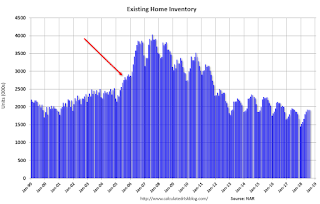And the decrease in inventory eventually helped me correctly call the bottom for house prices in early 2012, see: The Housing Bottom is Here.
And in 2015, it appeared the inventory build in several markets was ending, and that boosted price increases.
I don't have a crystal ball, but watching inventory helps understand the housing market.
Inventory, on a national basis, was up 2.7% year-over-year (YoY) in July, this the first YoY increase since early 2015.
The graph below shows the YoY change for non-contingent inventory in Houston, Las Vegas, Sacramento, and Phoenix (through August) and total existing home inventory as reported by the NAR (also through August).
 Click on graph for larger image.
Click on graph for larger image.This shows the YoY change in inventory for Houston, Las Vegas, Phoenix, and Sacramento. The black line is the year-over-year change in inventory as reported by the NAR.
Note that inventory in Sacramento was up 22% year-over-year in August (inventory was still very low), and has increased YoY for eleven consecutive months.
Also note that inventory was up 20% YoY in Las Vegas in August (red), the second consecutive month with a YoY increase.
Houston is a special case, and inventory was up for several years due to lower oil prices, but declined YoY recently as oil prices increased. Inventory was up slightly in Houston in August (but the YoY change might be distorted by Hurricane Harvey last year).
Inventory is a key for the housing market, and I am watching inventory for the impact of the new tax law and higher mortgage rates on housing. I expect national inventory will be up YoY at the end of 2018 (but still be low).
 The current slight YoY increase in inventory is nothing like what happened in 2005 and 2006. In 2005 (see red arrow), inventory kept increasing all year, and that was a sign the bubble was ending.
The current slight YoY increase in inventory is nothing like what happened in 2005 and 2006. In 2005 (see red arrow), inventory kept increasing all year, and that was a sign the bubble was ending.Although I expect inventory to increase YoY in 2018, I expect inventory to follow the normal seasonal pattern (not keep increasing all year).
So this is not comparable to late 2005 when inventory increased sharply signaling the end of the housing bubble.
Also inventory is still very low. Consider Sacramento and Las Vegas - two cities with large YoY increases in inventory - the recent increases pushed inventory in Sacramento to 1.9 months supply. And in Las Vegas, the recent increases pushed up the months-of-supply in Las Vegas to 1.8 months.
No comments:
Post a Comment
Note: Only a member of this blog may post a comment.